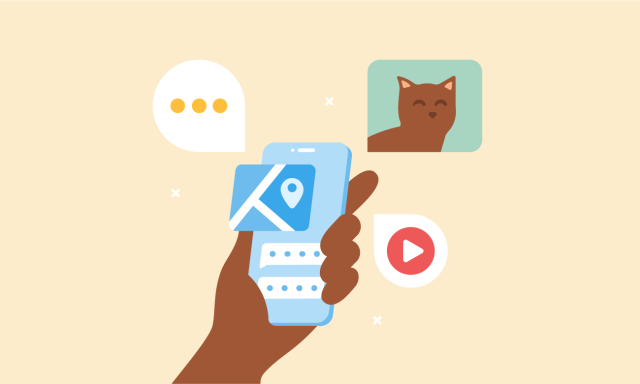In this article:
If you read my last post which went into depth about how you can use rich images and media with personalized content over the SMS/MMS channel to achieve business outcomes, you already know that using mobile channels in addition to email (which you are probably already using) is an easy next step to truly engaged customers and maximizing ROI on your marketing or operational budgets. You also already know that leveraging MMS messaging as a part of your customer engagement strategy can be a highly effective and cost-conscious way to be more relevant to your customers by creating a unique and personalized experience. Don't know all this? Go have another look. 🙄
Now that we understand using rich media has business benefits like increasing customer retention, improving marketing conversions, reducing churn, improving call center wait times and reducing the cost per customer support call, we can look to what the future holds for us on the journey towards real-time enriched messaging using technology like RCS, WhatsApp, Facebook, and other over-the-top (OTT) IP-messaging channels.
Presently, telecom industry regulators and leaders like the CTIA (creator and moderator of the Messaging Principles and Best Practices used by everyone in the messaging industry today) and FCC (who discuss, create and enforce regulations and standards such as the TCPA in the United States) have been evaluating business text messaging channels, including how they are regulated, monetized, and used by businesses, with the interest of the end-consumer in mind. You may remember the FCC ruling last year here - text messaging was reclassified as an Information Service instead of a Telecommunication Service (FCC, 2018). Additionally, USA and Canadian MNOs are now standardizing 10-digit long codes (10DLC) which have been somewhat of a "wild west" option for years and causing many headaches for consumers, regulators, brands and service providers alike. More info on 10DLC and what the future may hold here.
With the advent of new messaging technologies enabling even more personalized and relevant content to consumers, we can see the free market pushing mobile operators, enterprises and aggregators alike to innovate at the intersection of telecoms and internet technologies. With this, we are seeing new IP Messaging experiences being delivered through platforms like Facebook Messenger, WhatsApp Business and WeChat to name a few. We are now seeing movement in the telecom space to compete by providing new tech like Rich Communications Services (RCS) in partnership with Google Jibe and companies like Sinch. In 2015, Google purchased a company called Jibe Mobile (TechCrunch, 2015), and began leading the movement for the evolution of SMS messaging into RCS. Now brands like Subway, Booking.com, and Best Buy are experimenting with this technology, proving how customer experiences are greatly enhanced through a more interactive messaging flow, and are seeing results.
Now brands like Subway, Booking.com, and Best Buy are experimenting with this technology, proving how customer experiences are greatly enhanced through a more interactive messaging flow, and are seeing results.
For example, Subway is one brand that everyone knows and loves (Subway haters I see you, it's all good 😘). By implementing RCS, they managed to increase conversions on sandwich purchases.
"[Subway] conducted A/B testing, with one group receiving the offers via SMS and the other RCS. The words matched exactly, but the RCS version included brand and product images and buttons.
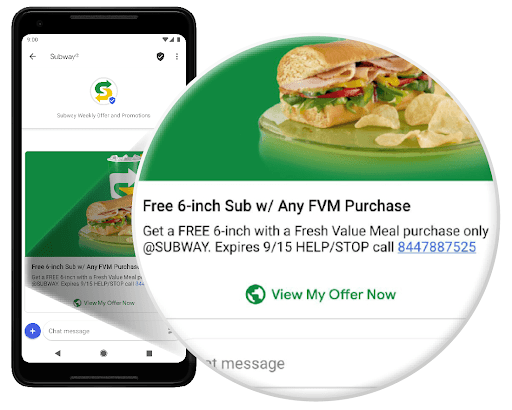
Subway ran two offers. The first week they promoted two foot-long sandwiches for $11.99. The second week, it was a $20 meal deal (which typically delivers a lower redemption than the other price point discount). The SMS-versus-RCS test campaigns required no additional training for Subway restaurant staff. [Carissa] Ganelli (Subway's Chief Digital Officer) sees big things ahead for Subway’s use of RCS (Google Jibe, 2019)":
We’re going to keep using RCS in more markets. It’s really exciting!

Pictured: Subway's business results versus SMS messaging when A/B testing against RCS.
The Opportunity (AND Reality-check)
If you think about how companies like Facebook and Apple have drastically reduced P2P SMS messaging revenues for Mobile Network Operators (MNOs) globally by staggering amounts in only the last 5-10 years, RCS messaging offers a new opportunity for both brands and MNOs to provide the same (and better) experience to consumers over their handset's existing preloaded text messaging app. The ability to deliver rich media via images, gifs, video, carousels, smart buttons, maps and more provides the biggest customer engagement opportunity to brands and carriers alike since the commercialization of the Internet (a statement many in the industry like to make but could be debatable). With this much positive sentiment about the future of RCS messaging, it's easy to see why everyone is flocking to it in droves. At the same time, it's easy to get ahead of ourselves.
While RCS provides a ton of exciting new capabilities and features, it is still at least 1-2 years out from being ubiquitous and available everywhere. Firstly, today RCS is only available on Android handsets. While Google's Android OS has the majority of the global smartphone market, Apple's iOS is still the king in the United States and Canada and cannot be ignored. Furthermore, Apple has released its own "flavor" of RCS via its iMessage app called Apple Business Chat (ABC). This creates a fragmented system for brands looking to deliver a consistent user experience to their customers who wish to interact with them on their preferred channel. Finally, while RCS today will work on virtually any Android handset running the latest software update of the Android Messages app, it also requires your mobile carrier to have the platform to serve and operate the RCS messaging flow, which requires an upgrade of carrier infrastructure. This is why companies like Sinch, who are heavily invested in the future of messaging, offer solutions like RCS as a Service (RCSaaS) to MNOs to speed up their time to market. This model emulates the same success we've had over the last 11 years enabling A2P monetization and other solutions to 350+ MNOs worldwide while making SMS and Voice communications accessible to businesses of all shapes and sizes.
Today, only Japan is 100% covered for RCS messaging (this may have changed by the time you read this!), with other lagging countries like USA and Canada on track to provide full subscriber coverage by Q1 2020 (GSMA RCS Global Launches, 2019). Still, there is a dedicated movement that is highly invested in the future of carriers upgrading and supporting the new messaging standard and features, and what used to seem like a pipe dream now seems inevitable.
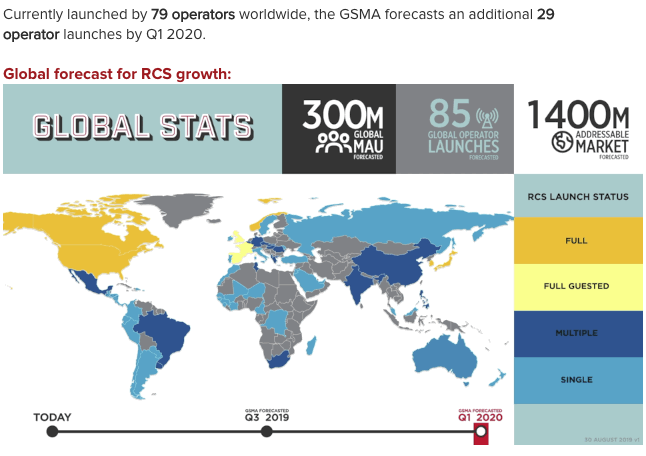
Interoperability between RCS and ABC (see above: RCS = Rich Communication Services on Android, ABC = Apple Business Chat on iOS) is something of a mystery still. In short, it doesn't exist… yet? With Apple recently changing their tone in how they approach business, now investing more in services and software with their hardware business slowing down, there are hopes that they will work with the mobile network operators and Google to make RCS and ABC work together, so that brands can interact the same way with their customers regardless of what handset is in their pocket. As someone who works in this industry every day helping brands get set up with new messaging channels and technology, I think I speak for everyone when I say that continued fragmentation and ambiguity about the future of messaging is an ongoing headache, and it would be wise for ubiquity to be enforced by regulators, handset manufacturers and mobile network operators that support one technology standard. These channels will certainly be regulated with consumers and end-users in mind, but the jury is still out on how this is standardized from the technology enablement perspective. With iOS 13 just being released this September and still no word on the future of Apple Business Chat, some are continuing to hope Apple is just working on this in the background with a goal for interoperability for iOS 14. This is still one year away (September 2020) assuming Apple continues its release schedule followed for more than 10 years.
Continued fragmentation and ambiguity about the future of messaging is an ongoing headache, and it would be wise for ubiquity to be enforced by regulators, handset manufacturers and mobile network operators that support one technology standard.
Now that we have prefaced reality, let's dive deep into the opportunities that RCS provides and how this compares to what is available today:
First, since we are all experts on MMS messaging now, and if you are reading this it is highly likely you've interacted with a brand online, let's take those two sources of knowledge and combine the best features all in one:
- RCS is available on almost every Android device in the world (except for our caveat mentioned above that your mobile carrier should also support it). Given that Android has the majority market share of smartphones today, this is a huge opportunity for everyone.
- People love interacting with brands when they are giving them something they want. This can be the service they are requesting, purchasing or new information about something they've opted into out of interest.
- Brands are investing heavily in customer experience, especially B2C brands in very competitive and saturated industries like Retail/eCommerce, Financial Services/FinTech, Travel/Hospitality and the On-Demand space which essentially runs on mobile and messaging technologies.
- User experience is top of mind for many brands today because getting an end-user's attention and getting them to make a decision to do more business with your brand could mean the difference between an extra click or filling out a form.
- A channel that is as ubiquitous as mobile handsets themselves, combined with secure and interactive real-time 2-way messaging could be the silver bullet that evolves the mobile channel from a fragmented customer experience ripe with clunky emails, too many apps and slow loading mobile websites, to a world of real-time, interactive, personalized one-to-one messaging creating unique and valuable experiences for customers. (Wouldn't you love to be on your customer's speed dial? It's time to make friends.)
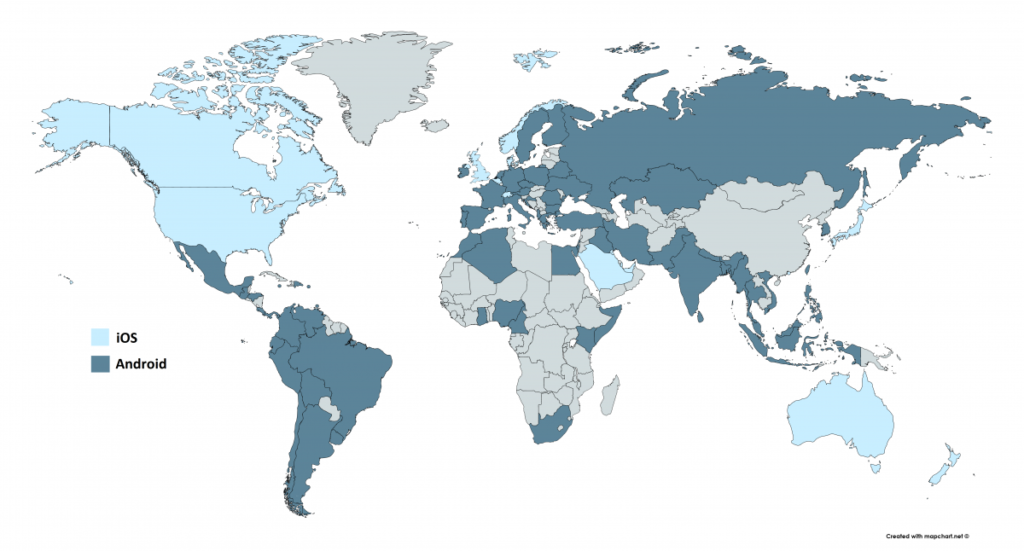
DeviceAtlas shows us their latest data of smartphone operating systems based upon their own device detection platform logging requests to mobile web globally. (DeviceAtlas, 2019). As we can see, outside the USA, Canada, Australia and a few other countries, the most popular mobile OS is Android by a large margin. The DeviceAtlas platform is trusted by brands like Adobe, IBM and Nike so we assume we can trust their data.
RCS Messaging is still in its infancy. But that doesn't mean people like myself and others are going to stop talking about it. In fact, expect to hear more from me and others on this subject as the situation develops before our eyes. Now is a more exciting time than ever if you work in mobile messaging, marketing, customer experience, telecom or any related field. Technology is truly enabling the next wave of commerce, and it's easy to get left behind without your finger on the pulse. This is where I come in to help educate brands on the latest trends and technology to get them thinking long-term about their business.
Stay tuned for the next article in my series on "How Your Brand Can Personalize Customer Experiences with MMS and Rich Messaging". We haven't even gotten to the fun part yet where we get really PERSONAL. Today, Sinch houses our own marketing agency called SinchEngage based in Seattle, and we are helping our clients get the most of leveraging these new messaging channels by enabling hyper-personalized rich media content delivered directly to the MMS/SMS inbox and any other mobile channel where an image or video can be displayed/viewed (this includes RCS, Mobile Web and Social Ads such as Facebook and Instagram Newsfeed). We are not like any other personalization technology available on the market because of the scale and level of personalization we can offer through a hands-on consultative approach that is focused on data and drives true measurable business outcomes for our customers.
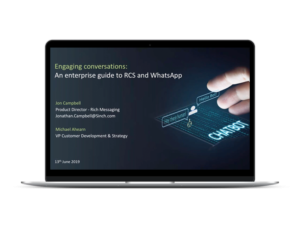
Sinch's webinar recording of Engaging conversations: An enterprise guide to RCS and WhatsApp hosted by our own Jon Campbell, Director of Rich Messaging and Michael Ahearn, VP of Customer Development & Strategy is now LIVE! You can get access to it here.
Want to learn more? Or just want to connect? Please feel free to reach out to me! I'd love to chat. Originally posted on LinkedIn by Aly Abji


